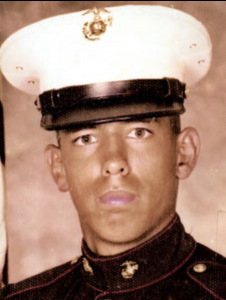
Andres Garcia from New Mexico, Eddy county.
Service era: Vietnam
Date of death: Thursday, May 15, 1975
Death details: Marine Corps Pfc. Daniel A. Benedett of Seattle, Wash., was buried May 15, 2013 at Arlington National Cemetery, along with Air Force 2nd Lt. Richard Vandegeer of Cleveland, Ohio; Navy Hospital Corpsman 1st Class Bernard Gause Jr., of Birmingham, Ala.; Hospitalman Ronald J. Manning of Steubenville, Ohio; Marine Corps servicemen Lance Cpl. Gregory S. Copenhaver of Lewistown, Pa.; Lance Cpl. Andres Garcia of Carlsbad, N.M.; Pfc. Lynn Blessing of Lancaster, Pa.; Pfc. Walter Boyd of Portsmouth, Va.; Pfc. James J. Jacques of La Junta, Colo.; Pfc. James R. Maxwell of Memphis, Tenn.; Pfc. Richard W. Rivernburgh of Schenectady, N.Y.; Pfc. Antonio R. Sandoval of San Antonio, Texas; and Pfc. Kelton R. Turner of St. Louis, Mo. On May 12, 1975, Khmer Rouge gunboats captured the S.S. Mayaguez in the Gulf of Thailand, approximately 60 nautical miles off the coast of Cambodia. After the vessel was taken to Koh Tang Island, U.S. aircraft began surveillance flights around the island. When efforts to secure the release of the ship and its crew failed, U.S. military forces began a rescue mission. Three days after the Mayaguez seizure, the Air Force dispatched six helicopters to the island. One of the helicopters came under heavy enemy fire and crashed into the surf with 26 men on board. Thirteen of the men were rescued at sea, leaving Benedett and 12 other service members unaccounted-for from the crash. Between 1991 and 2008, investigators conducted more than 10 investigations and excavations, led by Joint POW/MIA Accounting Command (JPAC). On three occasions, Cambodian authorities turned over remains believed to be those of American servicemen. In 1995, U.S. and Cambodian specialists conducted an underwater recovery of the helicopter crash site where they located remains, personal effects and aircraft debris associated with the loss. Between 2000 and 2004, all of the missing service members from this helicopter, except Benedett, were accounted-for. On January 30, 2013, Benedett was accounted-for. Scientists from JPAC and the Armed Forces Identification Laboratory (AFDIL) used circumstantial evidence and DNA process of elimination to account for his remains.
Cemetery: Arlington National
Source: National Archives, Department of Defense


